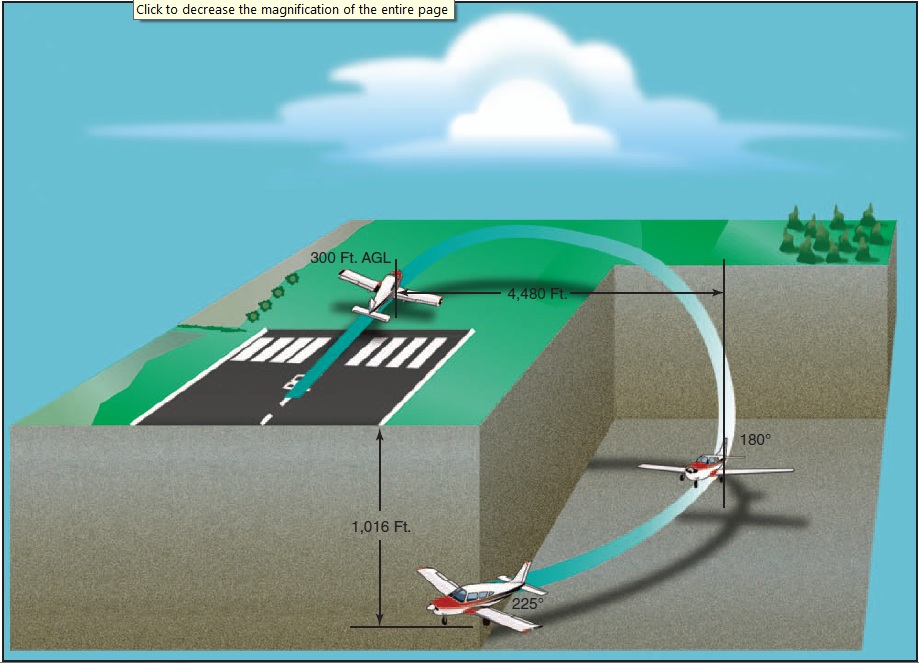
Chapter 16 Emergency Procedures
Table of Contents
Emergency Situations
Emergency Landings
Types of Emergency Landings
Psychological Hazards
Basic Safety Concepts
General
Attitude and Sink Rate Control
Terrain Selection
Airplane Configuration
Approach
Terrain Types
Confined Areas
Trees (Forest)
Water (Ditching) and Snow
Engine Failure After Takeoff (Single-Engine)
Emergency Descents
In-Flight Fire
Engine Fire
Electrical Fires
Cabin Fire
Flight Control Malfunction / Failure
Total Flap Failure
Asymmetric (Split) Flap
Loss of Elevator Control
Landing Gear Malfunction
Systems Malfunctions
Electrical System
Pitot-Static System
Abnormal Engine Instrument Indications
Door Opening In Flight
Inadvertent VFR Flight Into IMC
General
Recognition
Maintaining Airplane Control
Attitude Control
Turns
Climbs
Descents
Combined Maneuvers
Transition to Visual Flight

ENGINE FAILURE AFTER TAKEOFF
(SINGLE-ENGINE)
The altitude available is, in many ways, the controlling factor in the successful accomplishment of an emergency landing. If an actual engine failure should occur immediately after takeoff and before a safe maneuvering altitude is attained, it is usually inadvisable to attempt to turn back to the field from where the takeoff was made. Instead, it is safer to immediately establish the proper glide attitude, and select a field directly ahead or slightly to either side of the takeoff path.
The decision to continue straight ahead is often difficult to make unless the problems involved in attempting to turn back are seriously considered. In the first place, the takeoff was in all probability made into the wind. To get back to the takeoff field, a downwind turn must be made. This increases the groundspeed and rushes the pilot even more in the performance of procedures and in planning the landing approach. Secondly, the airplane will be losing considerable altitude during the turn and might still be in a bank when the ground is contacted, resulting in the airplane cartwheeling (which would be a catastrophe for the occupants, as well as the airplane). After turning downwind, the apparent increase in groundspeed could mislead the pilot into attempting to prematurely slow down the airplane and cause it to stall. On the other hand, continuing straight ahead or making a slight turn allows the pilot more time to establish a safe landing attitude, and the landing can be made as slowly as possible, but more importantly, the airplane can be landed while under control.
Concerning the subject of turning back to the runway following an engine failure on takeoff, the pilot should determine the minimum altitude an attempt of such a maneuver should be made in a particular airplane. Experimentation at a safe altitude should give the pilot an approximation of height lost in a descending 180° turn at idle power. By adding a safety factor of about 25 percent, the pilot should arrive at a practical decision height. The ability to make a 180° turn does not necessarily mean that the departure runway can be reached in a power-off glide; this depends on the wind, the distance traveled during the climb, the height reached, and the glide distance of the airplane without power. The pilot should also remember that a turn back to the departure runway may in fact require more than a 180° change in direction.
Consider the following example of an airplane which
has taken off and climbed to an altitude of 300 feet
AGL when the engine fails. [Figure 16-5 on next
page]. After a typical 4 second reaction time, the pilot
elects to turn back to the runway. Using a standard rate
(3° change in direction per second) turn, it will take 1
minute to turn 180°. At a glide speed of 65 knots, the
radius of the turn is 2,100 feet, so at the completion of
the turn, the airplane will be 4,200 feet to one side of
the runway. The pilot must turn another 45° to head the
airplane toward the runway. By this time the total
change in direction is 225° equating to 75 seconds plus
the 4 second reaction time. If the airplane in a power-
off glide descends at approximately 1,000 f.p.m., it
will have descended 1,316, feet placing it 1,016 feet
below the runway.

Figure 16-5. Turning back to the runway after engine failure.
PED Publication